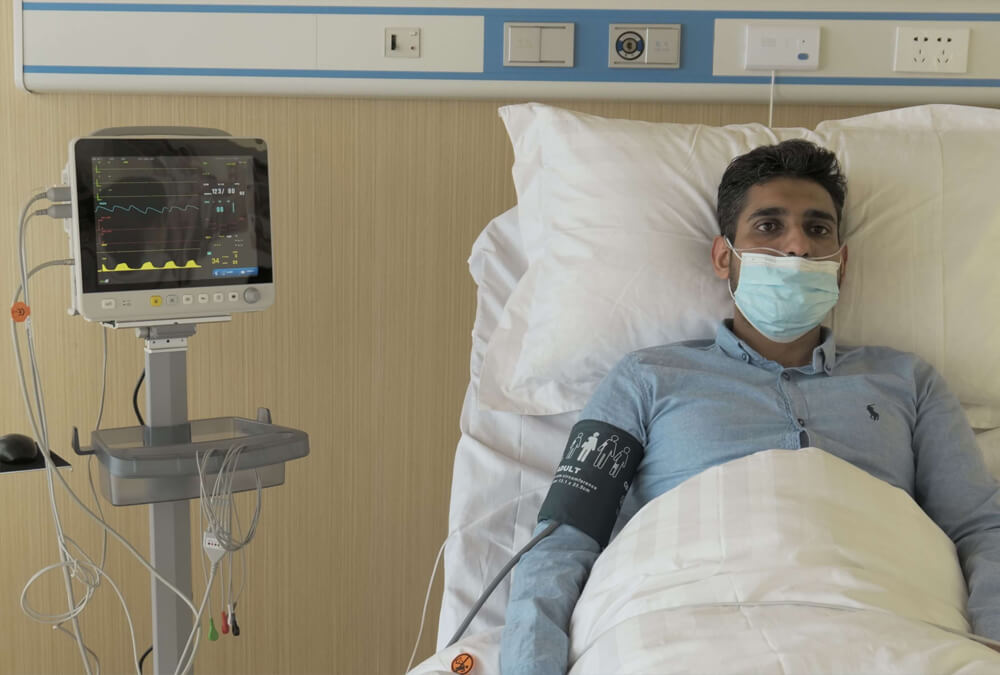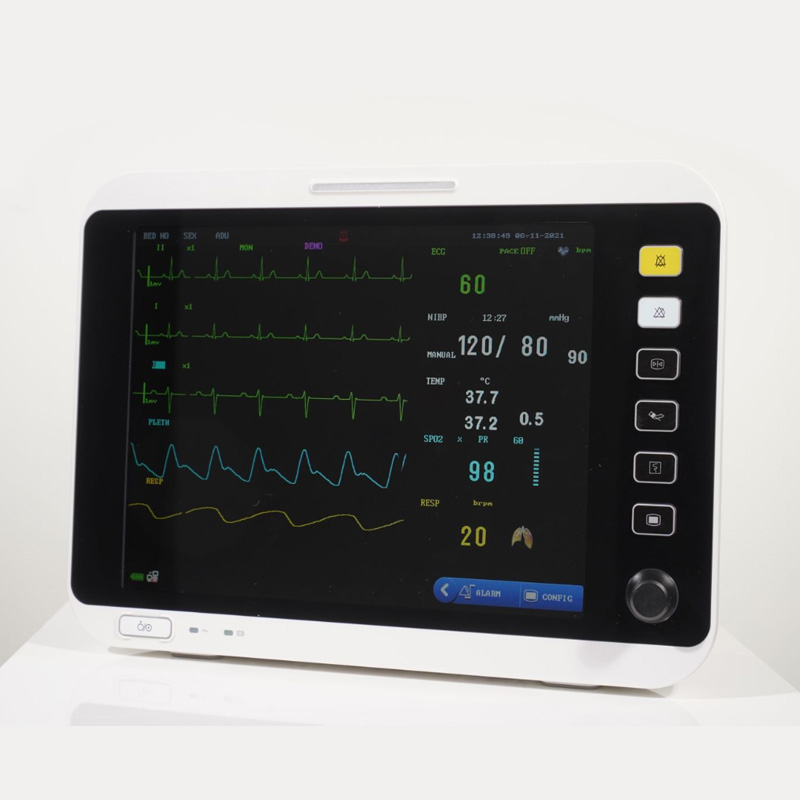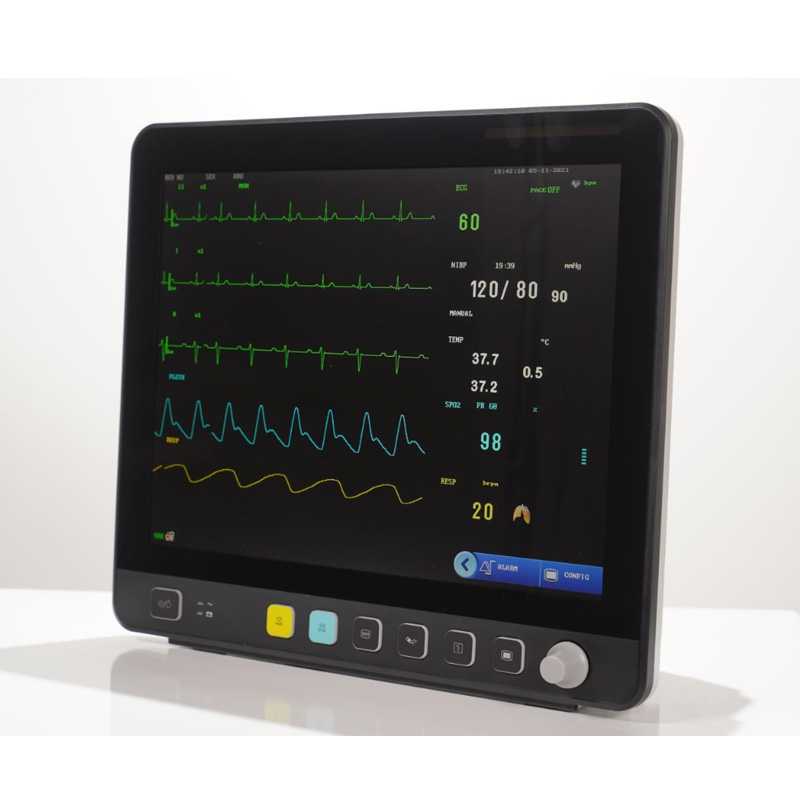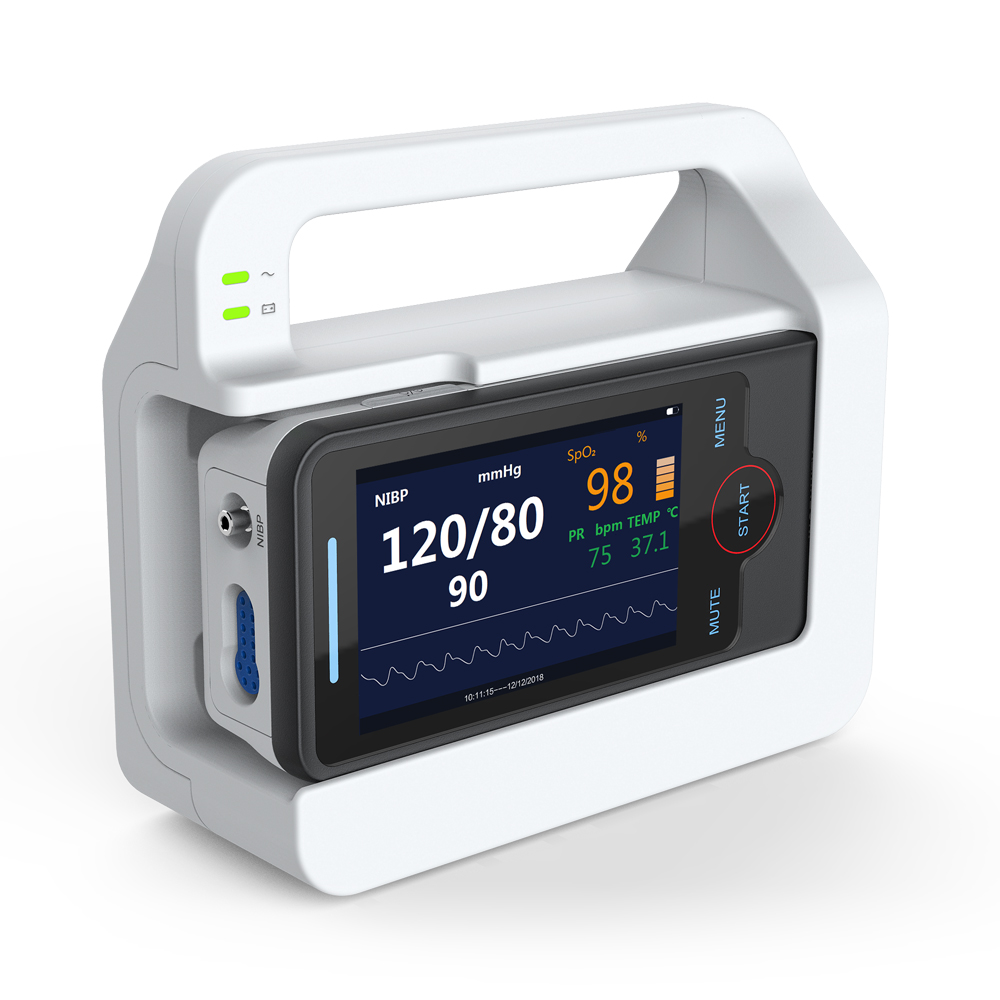Multiparameter monitor provides important information for medical patients with clinical diagnosis monitoring. It detects ecg signals of human body, the heart rate, blood oxygen saturation, blood pressure, breathing frequency, temperature and other important parameters in real-time, becomes a kind of important equipment for monitoring vital signs in patients. Yonker will be make a brief introduction for common problems and faults when in the process of using multiparameter monitor . For the specific questions can be consulted online customer service.
1. What is the difference between 3-lead and 5-lead cardiac conductors?
A: 3-lead electrocardiogram can only obtain I, II, III lead electrocardiogram, while 5-lead electrocardiogram can obtain I, II, III, AVR, AVF, AVL, V lead electrocardiogram.
In order to facilitate fast connection, we use color marking method to quickly stick the electrode in the corresponding position. 3 Lead cardiac wires are colored red, yellow, green or white, black, red; 5 lead cardiac wires are colored white, black, red, green and brown. The same color leads of the two cardiac wires are placed in different electrode positions. It is more reliable to use abbreviations RA, LA, RL, LL, C to determine the position than to memorize the color.
2. Why is it recommended to wear oxygen saturation fingercover first?
Because wearing the oximetry finger mask is much faster than connecting the ecg wire, it can monitor the patient's pulse rate and oximetry in the shortest time, allowing the medical staff to complete the assessment of the patient's most basic signs quickly .
3. Can the OXImetry finger sleeve and sphygmomanometer cuff be placed on the same limb?
Blood pressure measurement will block and affect arterial blood flow, resulting in inaccurate blood oxygen saturation monitoring during blood pressure measurement. Therefore, it is not recommended to wear oxygen saturation finger sleeve and automatic sphygmomanometer cuff on the same limb clinically.
4. Should electrodes be replaced when patients are undergoing continuous ECG monitoring?
It is necessary to replace the electrode, if long time sticks the electrode on the same part will lead to the occurrence of rash, blisters, so should be checked the skin frequently, even if the current skin is intact, also should replace the electrode and the adhesive site every 3 to 4 days, to avoid the occurrence of skin damage.

5. What should we pay attention to non-invasive blood pressure monitoring?
(1) Pay attention to avoid monitoring on the internal fistula, hemiplegia, the limbs with one side of breast cancer resection, the limbs with infusion, and the limbs with edema and hematoma and damaged skin. Attention should also be paid to patients with poor coagulation function and libriform cell disease to avoid medical disputes caused by blood pressure measurement.
(2) The measuring part should be replaced regularly. Experts suggest that it should be replaced every 4 hours. Avoid continuous measurement on one limb, resulting in purpura, ischemia and nerve damage in the limb rubbing with the cuff.
(3) When measuring adults, children and newborns, need to pay attention to the selection and adjustment of cuff and pressure value. Because the pressure applied to adults on children and newborns threatens the safety of children; And when the device is setted in a newborn, it will not measure adult blood pressure.
6. How is respiration detected without respiration monitoring moudel?
Respiration on the monitor relies on electrocardiogram electrodes to sense changes in thoracic impedance and display the waveform and data of respiration. Because the lower left and upper right electrodes are breath sensitive electrodes, their placement is important. The two electrodes should be positioned diagonally as far as possible to obtain the best breath wave. If the patient uses abdominal breathing primarily, the lower left electrode should be glued to the left side where abdominal heaves are most pronounced.
7. How to set alarm range for each parameter ?
Alarm setting principles: to ensure patient safety, minimize noise interference, not allowed to close the alarm function, except temporarily closed in the rescue , alarm range is not setted in the normal range, but should be a safe range.
Alarm parameters: heart rate 30% above and below their own heart rate; Blood pressure is setted according to medical advice, patient's condition and basic blood pressure; Oxygen saturation is setted according to the patient's condition; The alarm volume must be audible within the scope of the nurse's work; The alarm range should be adjusted at any time according to the situation and checked at least once per shift.
8. What are the reasons for the failure showing in waveform of ecg monitor display?
1. The electrode is not properly attached: the display indicates that the lead is off, which is caused by the electrode is not properly attached or the electrode is rubbed off due to the patient's movement.
2. Sweat and dirt: the patient sweats or the skin is not clean, which is not easy to conduct electricity, indirectly causing poor contact with the electrode.
3. Heart electrode quality problems: some electrode improperly stored, expired or aging.
4. Cable fault: The cable is aging or broken.
6. The electrode is not placed correctly.
7. The CABLE connecting to the ECG board or the MAIN control board or the main control board is faulty.
8. Not connected ground wire: ground wire plays a very important role in the normal display of the waveform, not grounding wire, is also a factor causing the waveform.
9. No monitor waveform:
1. Check:
Firstly, confirming whether the electrode is properly pasted, checking the position of the heart electrode, the quality of the heart electrode, and whether there is a problem with the lead wire on the basis of the electrode sticking and quality. Checking if the connection steps are correct, and whether the operator's lead mode is connected according to the connection method of the ecg monitor, so as to avoid the lazy diagram saving method of connecting five links only three links.
If the ECG signal cable does not return after the fault is rectified, maybe the ECG signal cable on the parameter socket board in poor contact, or the connection cable or main control board between the ECG board and the main control board is faulty.
2. Review:
1. Check all external parts of cardiac conductance (the three/five extension wires in contact with the human body should be conductive to the corresponding three/five pins on the ecg plug. If the resistance is infinite, the lead wire should be replaced). Method: taking out the heart conductance wire, align the convex surface of the plug of the lead wire with the groove of the "heart conductance" jack on the front panel of the host computer,
2, Exchange this ecg cable with other machines to confirm whether ecg cable failure, cable aging, pin damage.
3. If the waveform channel of ecg display shows "no signal receiving", it indicates that there is a problem in communication between the ECG measurement module and the host. If the message is still displayed after shutdown and restart, you need to contact the supplier.
3. Check:
1. Connection steps should be correct:
A. Wipe 5 specific positions of human body with sand on the electrode, and then use 75% ethanol to clean the surface of the measurement site, so as to remove cuticle and sweat stains on human skin and prevent bad contact with the electrode.
B. Connect the electrode head of the electrocardioconductance wire to the top electrode of the 5 electrodes.
C. After ethanol volatilizes clean, stick the 5 electrodes to the specific position after cleaning to make them contact reliably and not fall off.
2. Propaganda and education related to patients and their families: tell patients and other personnel not to pull the electrode wire and lead wire, and tell patients and their relatives not to apply and adjust the monitor without authorization, which may cause damage to the device. Some patients and their family members have a sense of mystery and dependence on the monitor, and the changes of the monitor will cause anxiety and panic. Nursing staff should do a good job of adequate, necessary explanation, in order to avoid interference with normal nursing work, affect the nurse-patient relationship.
3. Pay attention to the maintenance of the monitor when it is used for a long time. The electrode is easy to fall off after long-term application, which affects the accuracy and monitoring quality. 3-4D replace once; At the same time, check and pay attention to the cleaning and disinfection of the skin, especially in hot summer.
4. If serious abnormalities are found in the device during the review and maintenance monitoring process by professional personnel, it is best to ask professional ecg laboratory personnel to review and diagnose, and maintenance by professional personnel of the manufacturer.
5. Connect the ground wire when connecting. Method: Connect the end with copper sheathed to the ground terminal on the rear panel of the host.
Post time: Jul-01-2022





